Environmental and Health Factors as Organic Fruit Purchase Drivers and the Mediating Role of Price and Effort
Abstract
1. Introduction
2. Materials and Methods
3. Results
3.1. Measurement Model Evaluation
3.2. Structural Model Evaluation
3.3. Moderate Effects Evalaution
4. Discussion
5. Conclusions
Supplementary Materials
Author Contributions
Funding
Institutional Review Board Statement
Informed Consent Statement
Data Availability Statement
Conflicts of Interest
Appendix A. Applied instrument
- H1
- Contains many vitamins and minerals.
- H2
- Maintains health.
- H3
- It is nutritious.
- H4
- It has a high protein content.
- H5
- Good for skin, teeth, hair, nails, etc.
- H6
- It is high in fiber and dietary fiber.
- F1
- Conventional food products available on the market contain pesticide residues.
- F2
- Agricultural products from conventional agriculture cause disease.
- F3
- Exclusive ordinary food consumption could lead to lifestyle-related diseases such as cancer, asthma, obesity, etc. in the long term.
- F4
- Ordinary food consumption reduces longevity.
- F5
- The environment suffers from conventional agricultural practices.
- F6
- I avoid/reduce fruit consumption for fear about pesticide residues in food products.
- EM1
- The current development way is destroying the environment.
- EM2
- Environmental damage will be irreversible.
- EM3
- I practice environmental saving activities.
- EM4
- I prefer to consume recycled products.
- EM5
- I throw my garbage in different containers.
- E1
- I have time and am willing to travel extra distance for purchasing organic fruit.
- E2
- I am willing to visit several different stores, especially to buy organic fruit.
- E3
- Organic food is worth the extra effort it can take to buy it.
- E4
- I switch grocery stores if my local supermarket does not carry organic food.
- PP1
- Organic food is too expensive for me.
- PP2
- Buying organic products is worth the effort.
- PP3
- I prefer lower-cost substitutes.
- BA1
- Buying organic fruit is a very good idea.
- BA2
- Buying organic fruit is very important.
- BA3
- Buying organic fruit is very wise.
- PI1
- I intend to buy organic fruit in the future.
- PI2
- I hope to buy different kinds of organic fruit in the future.
- PI3
- I want to buy organic fruit in the future.
References
- Sabbe, S.; Verbeke, W.; Van Damme, P. Familiarity and purchasing intention of Belgian consumers for fresh and processed tropical fruit products. Br. Food J. 2008, 110, 805–818. [Google Scholar] [CrossRef]
- Kamenidou, I.C.; Mamalis, S.A.; Pavlidis, S.; Bara, E.Z. Segmenting the Generation Z Cohort University Students Based on Sustainable Food Consumption Behavior: A Preliminary Study. Sustainability 2019, 11. [Google Scholar] [CrossRef]
- Sijtsema, S.J.; Reinders, M.J.; Hiller, S.R.; Guardia, M.D. Fruit and snack consumption related to sweet, sour and salty taste preferences. Br. Food J. 2012, 114, 1032–1046. [Google Scholar] [CrossRef]
- Petrontino, A.; Frem, M.; Fucilli, V.; Tricarico, G.; Bozzo, F. Health-Nutrients and Origin Awareness: Implications for Regional Wine Market-Segmentation Strategies Using a Latent Analysis. Nutrientes 2022, 14, 1385. [Google Scholar] [CrossRef]
- Kumar, N.; Kapoor, S. Do labels influence purchase decisions of food products? Study of young consumers of an emerging market. Br. Food J. 2017, 119, 218–229. [Google Scholar] [CrossRef]
- Mancini, P.; Marchini, A.; Simeone, M. Which are the sustainable attributes affecting the real consumption behaviour? Consumer understanding and choices. Br. Food J. 2017, 119, 1839–1853. [Google Scholar] [CrossRef]
- Rodríguez-Osiac, L.; Pizarro-Quevedo, T. Law of Food Labelling and Advertising: Chile innovating in public nutrition once again. Rev. Chil. Pediatr. 2018, 89, 579–581. [Google Scholar] [CrossRef] [PubMed]
- Irz, X.; Leroy, P.; Requillart, V.; Soler, L.G. Economic assessment of nutritional recommendations. J. Health Econ. 2015, 39, 188–210. [Google Scholar] [CrossRef]
- Meiselman, H.L. The future in sensory/consumer research: Evolving to a better science. Food. Qual. Prefer. 2013, 27, 208–214. [Google Scholar] [CrossRef]
- Coderoni, S.; Perito, M.A.; Cardillo, C. Consumer behaviour in Italy. Who spends more to buy a Mediterranean Diet? New Medit 2017, 16, 38–46. [Google Scholar]
- Bowyer, S.; Caraher, M.; Eilbert, K.; Carr-Hill, R. Shopping for food: Lessons from a London borough. Br. Food J. 2009, 111, 452–474. [Google Scholar] [CrossRef]
- Bezerra, I.N.; Moreira, T.M.; Cavalcante, J.B.; Souza, A.D.; Sichieri, R. Food consumed outside the home in Brazil according to places of purchase. Rev. Saude Publica 2017, 51, 15. [Google Scholar] [CrossRef]
- Rose, D.; Hutchinson, P.L.; Bodor, J.N.; Swalm, C.M.; Farley, T.A.; Cohen, D.A.; Rice, J.C. Neighborhood Food Environments and Body Mass Index the Importance of In-Store Contents. Am. J. Prev. Med. 2009, 37, 214–219. [Google Scholar] [CrossRef]
- Guney, O.I.; Sangun, L. How COVID-19 affects individuals’ food consumption behaviour: A consumer survey on attitudes and habits in Turkey. Br. Food J. 2021, 123, 2307–2320. [Google Scholar] [CrossRef]
- Zamora-Valdés, P. Política nacional de alimentación y nutrición de Chile. Rev. Chil. Nutr. 2022, 49, 39–42. [Google Scholar] [CrossRef]
- Echeverría, G.; Tiboni, O.; Berkowitz, L.; Pinto, V.; Samith, B.; von Schultzendorff, A.; Pedrals, N.; Bitran, M.; Ruini, C.; Ryff, C.D.; et al. Mediterranean Lifestyle to Promote Physical, Mental, and Environmental Health: The Case of Chile. Int. J. Environ. Res. Public Health 2020, 17, 8482. [Google Scholar] [CrossRef] [PubMed]
- Carson, R.A.; Hamel, Z.; Giarrocco, K.; Baylor, R.; Mathews, L.G. Buying in: The influence of interactions at farmers’ markets. Agric. Human Values 2016, 33, 861–875. [Google Scholar] [CrossRef]
- Wojciechowska-Solis, J.; Barska, A. Exploring the Preferences of Consumers’ Organic Products in Aspects of Sustainable Consumption: The Case of the Polish Consumer. Agriculture 2021, 11, 138. [Google Scholar] [CrossRef]
- Aydogdu, M.H.; Kaya, F. Factors Affecting Consumers’ Consumption of Organic Foods: A Case Study in GAP-Sanliurfa in Turkey. J. Agric. Sci. Technol. 2020, 22, 347–359. [Google Scholar]
- Stranieri, S.; Ricci, E.C.; Banterle, A. Convenience food with environmentally-sustainable attributes: A consumer perspective. Appetite 2017, 116, 11–20. [Google Scholar] [CrossRef] [PubMed]
- Smed, S. Information and consumer perception of the organic attribute in fresh fruits and vegetables. Agric. Econ. 2012, 43, 33–48. [Google Scholar] [CrossRef]
- Botonaki, A.; Polymeros, K.; Tsakiridou, E.; Mattas, K. The role of food quality certification on consumers food choices. Br. Food J. 2006, 108, 77–90. [Google Scholar] [CrossRef]
- Padel, S.; Foster, C. Exploring the gap between attitudes and behaviour—Understanding why consumers buy or do not buy organic food. Br. Food J. 2005, 107, 606–625. [Google Scholar] [CrossRef]
- Ali, J.; Kapoor, S.; Moorthy, J. Buying behaviour of consumers for food products in an emerging economy. Br. Food J. 2010, 112, 109–124. [Google Scholar] [CrossRef]
- Jose, H.; Kuriakose, V. Emotional or logical: Reason for consumers to buy organic food products. Br. Food J. 2021, 123, 3999–4016. [Google Scholar] [CrossRef]
- Akpinar, M.G.; Aykin, S.M.; Sayin, C.; Ozkan, B. The role of demographic variables in purchasing decisions on fresh fruit and vegetables. J. Food Agric. Environ. 2009, 7, 106–110. [Google Scholar]
- Rodriguez-Bermudez, R.; Miranda, M.; Orjales, I.; Ginzo-Villamayor, M.J.; Al-Soufi, W.; Lopez-Alonso, M. Consumers’ perception of and attitudes towards organic food in Galicia (Northern Spain). Int. J. Consum. Stud. 2020, 44, 206–219. [Google Scholar] [CrossRef]
- Skreli, E.; Imami, D.; Chan, C.; Canavari, M.; Zhllima, E.; Pire, E. Assessing consumer preferences and willingness to pay for organic tomatoes in Albania: A conjoint choice experiment study Span. J. Agric. Res. 2017, 15, e0114. [Google Scholar] [CrossRef]
- Diaz, F.J.; Pleite, F.M.; Paz, J.M.; Garcia, P.G. Consumer knowledge, consumption, and willingness to pay for organic tomatoes. Br. Food J. 2012, 114, 318–334. [Google Scholar] [CrossRef]
- Martins, A.P.D.; Bezerra, M.D.; Marques, S.; Brito, A.F.; Neto, J.C.D.; Galvao, J.G.B.; de Lima, D.M.; Rangel, A.H.N. Consumer behavior of organic and functional foods in Brazil. Food Sci. Technol. 2020, 40, 469–475. [Google Scholar] [CrossRef]
- Kuhar, A.; Juvancic, L. what determines purchasing behaviour for organic and integrated fruits and vegetables? Bulg. J. Agric. Sci. 2010, 16, 111–122. [Google Scholar]
- Sorqvist, P.; Haga, A.; Langeborg, L.; Holingren, M.; Wallinder, M.; Nostl, A.; Seager, P.B.; Marsh, J.E. The green halo: Mechanisms and limits of the eco-label effect. Food. Qual. Prefer. 2015, 43, 1–9. [Google Scholar] [CrossRef]
- Aschemann-Witzel, J.; Ares, G.; Thogersen, J.; Monteleone, E. A sense of sustainability?—How sensory consumer science can contribute to sustainable development of the food sector. Trends Food Sci. Technol. 2019, 90, 180–186. [Google Scholar] [CrossRef]
- Kim, J.; Rundle-Thiele, S.; Knox, K.; Burke, K.; Bogomolova, S. Consumer perspectives on household food waste reduction campaigns. J. Clean Prod. 2020, 243. [Google Scholar] [CrossRef]
- Gaiani, S.; Caldeira, S.; Adorno, V.; Segre, A.; Vittuari, M. Food wasters: Profiling consumers’ attitude to waste food in Italy. Waste Manage. 2018, 72, 17–24. [Google Scholar] [CrossRef]
- Deliza, R.; Rosenthal, A.; Hedderley, D.; Jaeger, S.R. Consumer perception of irradiated fruit: A case study using choice-based conjoint analysis. J. Sens. Stud. 2010, 25, 184–200. [Google Scholar] [CrossRef]
- Fischer, A.R.; Frewer, L.J.; Nauta, M.J. Toward improving food safety in the domestic environment: A multi-item Rasch scale for the measurement of the safety efficacy of domestic food-handling practices. Risk Anal. 2006, 26, 1323–1338. [Google Scholar] [CrossRef]
- Crofton, E.C.; Marke, A.; Scannell, A.G. Consumers’ expectations and needs towards healthy cereal based snacks An exploratory study among Irish adults. Br. Food J. 2013, 115, 1130–1148. [Google Scholar] [CrossRef]
- Atalah, S.E. Epidemiology of obesity in Chile. Rev. Médica Clínica Las Condes 2012, 23, 117–123. [Google Scholar] [CrossRef][Green Version]
- Adasme-Berrios, C.; Sanchez, M.; Jara-Rojas, R.; Engler, A.; Rodriguez, M.; Mora, M. Who are the potential consumers of organic fruits and vegetables in Central Chile? A CHAID approach. Rev. De La Fac. De Cienc. Agrarias. Univ. Nac. De Cuyo 2015, 47, 193–208. [Google Scholar]
- Martinez-Carrasco, L.; Brugarolas, M.; Martinez-Poveda, A.; Ruiz, J.J.; Garcia-Martinez, S. Modelling perceived quality of tomato by structural equation analysis. Br. Food J. 2012, 114, 1414–1431. [Google Scholar] [CrossRef]
- Halbrendt, C.; Tuan, F.; Gempesaw, C.; Dolketz, D. Rural chinese food-consumption—The case guangdong. Am. J. Agr. Econ. 1994, 76, 794–799. [Google Scholar] [CrossRef]
- Aigner, A.; Wilken, R.; Geisendorf, S. The Effectiveness of Promotional Cues for Organic Products in the German Retail Market. Sustainability 2019, 11, 6986. [Google Scholar] [CrossRef]
- Liu, K.Y.; Lan, Y.; Li, W. Behavior-based pricing between organic and general food enterprises. Br. Food J. 2019, 122, 107–121. [Google Scholar] [CrossRef]
- Vega-Muñoz, A.; Gil-Marín, M.; Contreras-Barraza, N.; Salazar-Sepúlveda, G.; Losada, A.V. How to Measure Organic Fruit Consumer Behavior: A Systematic Review. Horticulturae 2022, 8, 318. [Google Scholar] [CrossRef]
- Boca, G.D. Factors Influencing Consumer Behavior in Sustainable Fruit and Vegetable Consumption in Maramures County, Romania. Sustainability 2021, 13, 1812. [Google Scholar] [CrossRef]
- Scarpa, R.; Thiene, M. Organic food choices and Protection Motivation Theory: Addressing the psychological sources of heterogeneity. Food Qual. Prefer. 2011, 22, 532–541. [Google Scholar] [CrossRef]
- Steptoe, A.; Pollard, T.M.; Wardle, J. Development of a measure of the motives underlying the selection of food: The food choice questionnaire. Appetite 1995, 25, 267–284. [Google Scholar] [CrossRef]
- Gil, J.M.; Gracia, A.; Sanchez, M. Market segmentation and willingness to pay for organic products in Spain. Int. Food Agribus. Manag. Rev. 2000, 3, 207–226. [Google Scholar] [CrossRef]
- Dickieson, J.; Arkus, V.; Wiertz, C. Factors That Influence the Purchase of Organic Food: A Study of Consumer Behaviour in The UK; Cass Business School: London, UK, 2009. [Google Scholar]
- Lichtenstein, D.R.; Burton, S. The relationship between perceived and objective price-quality. J. Mark. Res. 1989, 26, 429–443. [Google Scholar] [CrossRef]
- Magnusson, M.K.; Arvola, A.; Hursti, U.K.K.; Åberg, L.; Sjödén, P.O. Attitudes towards organic foods among Swedish consumers. Br. Food J. 2001, 103, 209–227. [Google Scholar] [CrossRef]
- Ajzen, I. The theory of planned behavior. Organ. Behav. Hum. Decis. Process. 1991, 50, 179–211. [Google Scholar] [CrossRef]
- Hair, J.F., Jr.; Hult, G.T.M.; Ringle, C.M.; Sarstedt, M. A Primer on Partial Least Squares Structural Equation Modeling (PLS-SEM); Sage publications: Thousand Oaks, CA, USA, 2021. [Google Scholar]
- Ringle, C.M.; Wende, S.; Becker, J.M. SmartPLS 3; SmartPLS GmbH: Boenningstedt, Germany, 2015. [Google Scholar]
- Hofstede, G. Dimensionalizing cultures: The Hofstede model in context. Online Read. Psychol. Cult. 2011, 2, 2307-0919. [Google Scholar] [CrossRef]
- Fornell, C.; Bookstein, F.L. Two structural equation models: LISREL and PLS applied to consumer exit-voice theory. J. Mark. Res. 1982, 19, 440–452. [Google Scholar] [CrossRef]
- Wold, H. Systems under indirect observation using PLS. In A Second Generation of Multivariate Analysis, Volume I: Methods; Fornell, C., Ed.; Praeger: New York, NY, USA, 1982; pp. 325–347. [Google Scholar]
- Falk, R.F.; Miller, N.B. A Primer for Soft Modeling; University of Akron Press: Akron, OH, USA, 1992. [Google Scholar]
- Chin, W.W. The partial least squares approach to structural equation modeling. Mod. Methods Bus. Res. 1998, 295, 295–336. [Google Scholar]
- Jensen, A.; Clausen, T.H. Origins and emergence of exploration and exploitation capabilities in new technology-based firms. Technol. Forecast. Soc. Change 2017, 120, 163–175. [Google Scholar] [CrossRef]
- Rezaei, S. Segmenting consumer decision-making styles (CDMS) toward marketing practice: A partial least squares (PLS) path modeling approach. J. Retail. Consum. Serv. 2015, 22, 1–15. [Google Scholar] [CrossRef]
- Dijkstra, T.K.; Henseler, J. Consistent and asymptotically normal PLS estimators for linear structural equations. Comput. Stat. Data Anal. 2015, 81, 10–23. [Google Scholar] [CrossRef]
- Streukens, S.; Leroi-Werelds, S. Bootstrapping and PLS-SEM: A step-by-step guide to get more out of your bootstrap results. Eur. Manag. J. 2016, 34, 618–632. [Google Scholar] [CrossRef]
- Henseler, J.; Ringle, C.M.; Sarstedt, M. A new criterion for assessing discriminant validity in variance-based structural equation modeling. J. Acad. Mark. Sci. 2015, 43, 115–135. [Google Scholar] [CrossRef]
- Fornell, C.; Larcker, D.F. Structural Equation Models with Unobservable Variables and Measurement Error: Algebra and Statistics. J. Mark. Res. 1981, 18, 382–388. [Google Scholar] [CrossRef]
- Preacher, K.J.; Hayes, A.F. SPSS and SAS procedures for estimating indirect effects in simple mediation models. Behav. Res. Methods 2004, 36, 717–731. [Google Scholar] [CrossRef] [PubMed]
- Sadiq, M.A.; Rajeswari, B.; Ansari, L.; Danish Kirmani, M. The role of food eating values and exploratory behaviour traits in predicting intention to consume organic foods: An extended planned behaviour approach. J. Retail. Consum. Serv. 2021, 59, 102352. [Google Scholar] [CrossRef]
- Țigan, E.; Brînzan, O.; Obrad, C.; Lungu, M.; Mateoc-Sîrb, N.; Milin, I.A.; Gavrilaș, S. The Consumption of Organic, Traditional, and/or European Eco-Label Products: Elements of Local Production and Sustainability. Sustainability 2021, 13, 9944. [Google Scholar] [CrossRef]
- Moor, U.; Moor, A.; Põldma, P.; Heinmaa, L. Consumer preferences of apples in Estonia and changes in attitudes over five years. Agric. Food Sci. 2014, 23, 135–145. [Google Scholar] [CrossRef]
- Rana, J.; Paul, J. Health motive and the purchase of organic food: A meta-analytic review. Int. J. Consum. Stud. 2020, 44, 162–171. [Google Scholar] [CrossRef]
- Perlman, Y.; Ozinci, Y.; Westrich, S. Pricing decisions in a dual supply chain of organic and conventional agricultural products. Ann Oper Res. 2022, 314, 601–616. [Google Scholar] [CrossRef]
- Krystallis, A.; Vassallo, M.; Chryssohoidis, G. The usefulness of Schwartz’s ‘Values Theory’ in understanding consumer behaviour towards differentiated products. J. Mark. Manag. 2012, 28, 1438–1463. [Google Scholar] [CrossRef]
- White, K.; Habib, R.; Hardisty, D.J. How to SHIFT consumer behaviors to be more sustainable: A literature review and guiding framework. J. Mark. 2019, 83, 22–49. [Google Scholar] [CrossRef]
- Bryła, P. Who Reads Food Labels? Selected Predictors of Consumer Interest in Front-of-Package and Back-of-Package Labels during and after the Purchase. Nutrients 2020, 12, 2605. [Google Scholar] [CrossRef]
- Wojciechowska-Solis, J.; Kowalska, A.; Bieniek, M.; Ratajczyk, M.; Manning, L. Comparison of the Purchasing Behaviour of Polish and United Kingdom Consumers in the Organic Food Market during the COVID-19 Pandemic. Int. J. Environ. Res. Public Health 2022, 19, 1137. [Google Scholar] [CrossRef] [PubMed]
- Hansmann, R.; Baur, I.; Binder, C.R. Increasing organic food consumption: An integrating model of drivers and barriers. J. Clean. Prod. 2020, 275, 123058. [Google Scholar] [CrossRef]
- Pearson, D.; Henryks, J.; Jones, H. Organic food: What we know (and do not know) about consumers. Renew. Agric. Food Syst. 2011, 26, 171–177. [Google Scholar] [CrossRef]
- Liang, R.D. Predicting intentions to purchase organic food: The moderating effects of organic food prices. Br. Food J. 2016, 118, 183–199. [Google Scholar] [CrossRef]
- Radzyminska, M.; Jakubowska, D. The conceptualization of novel organic food products: A case study of Polish young consumers. Br. Food J. 2019, 121, 1884–1898. [Google Scholar] [CrossRef]
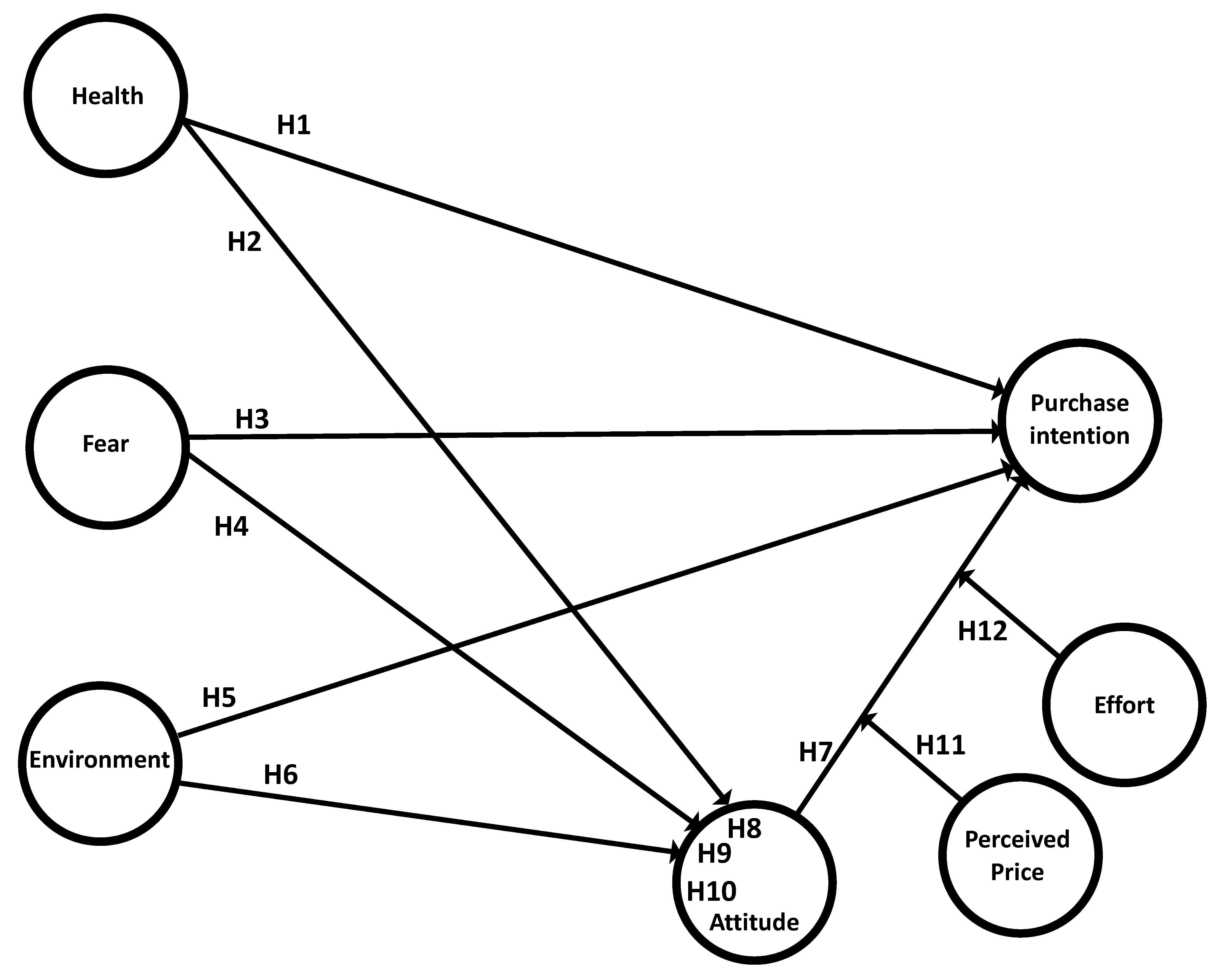
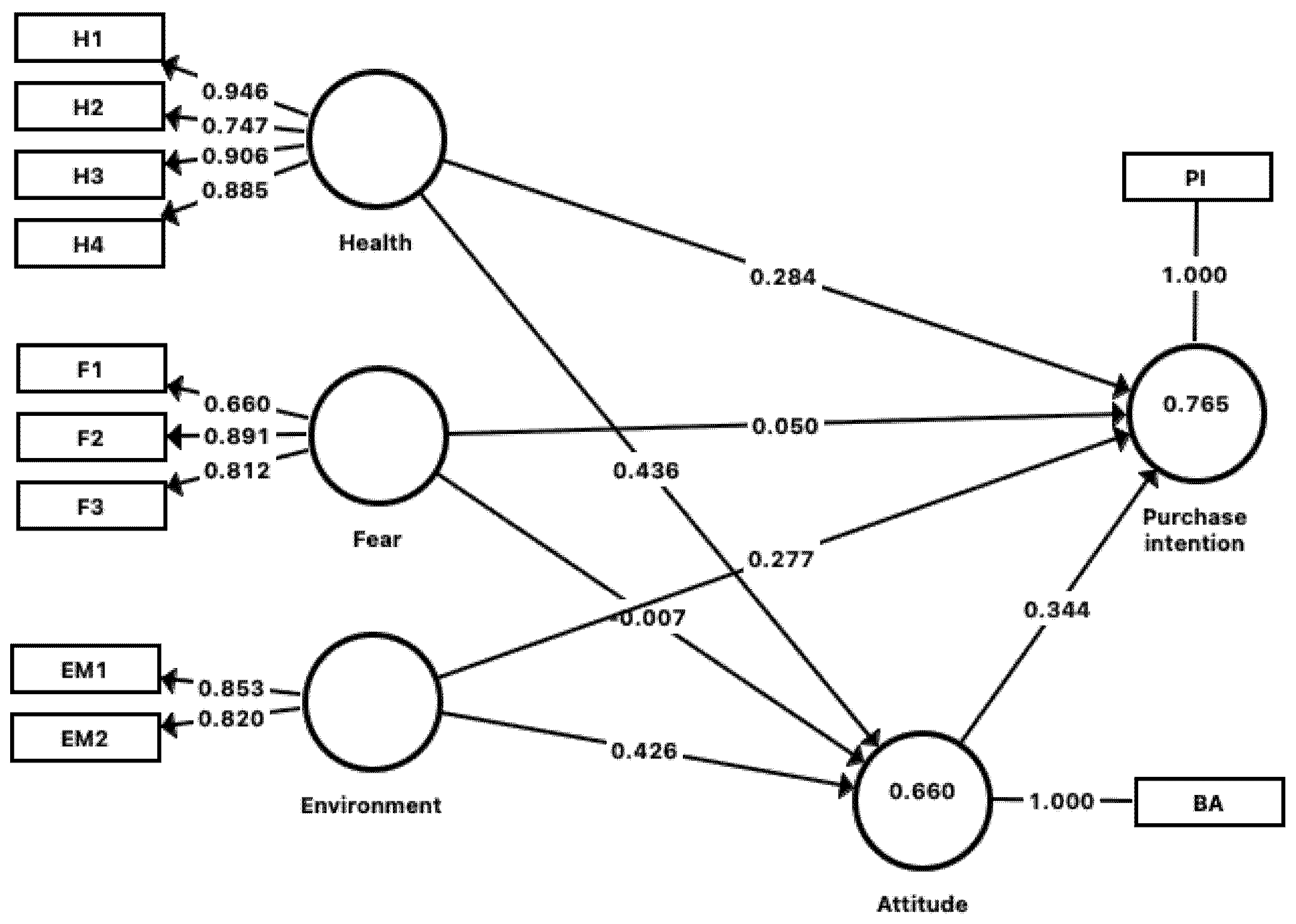
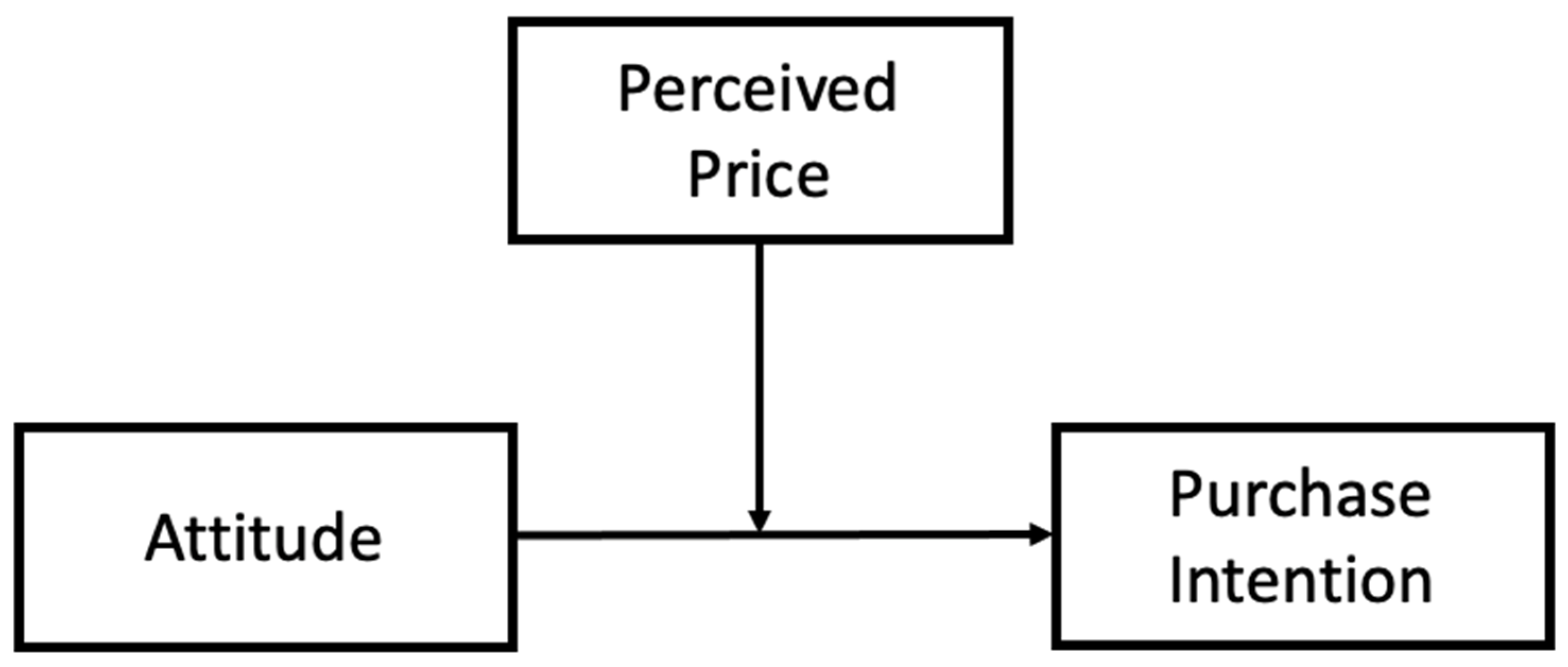
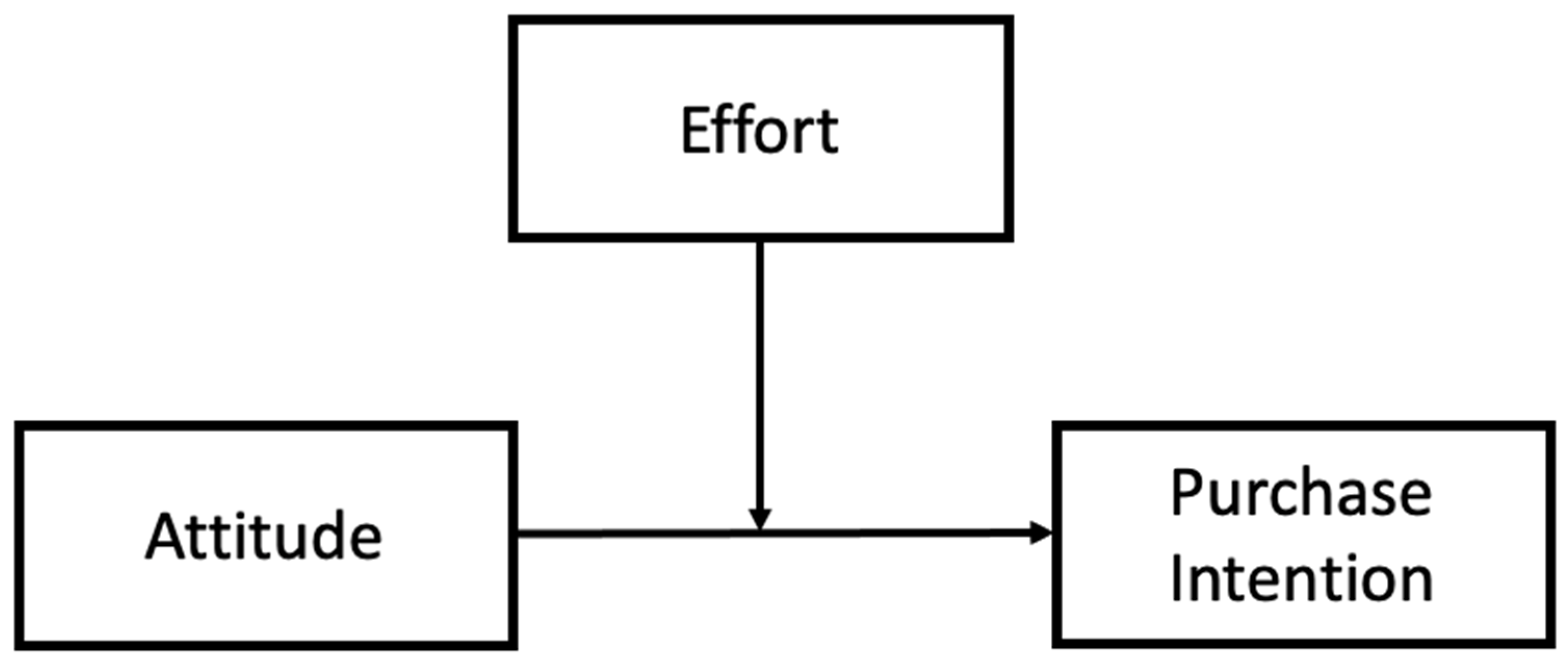
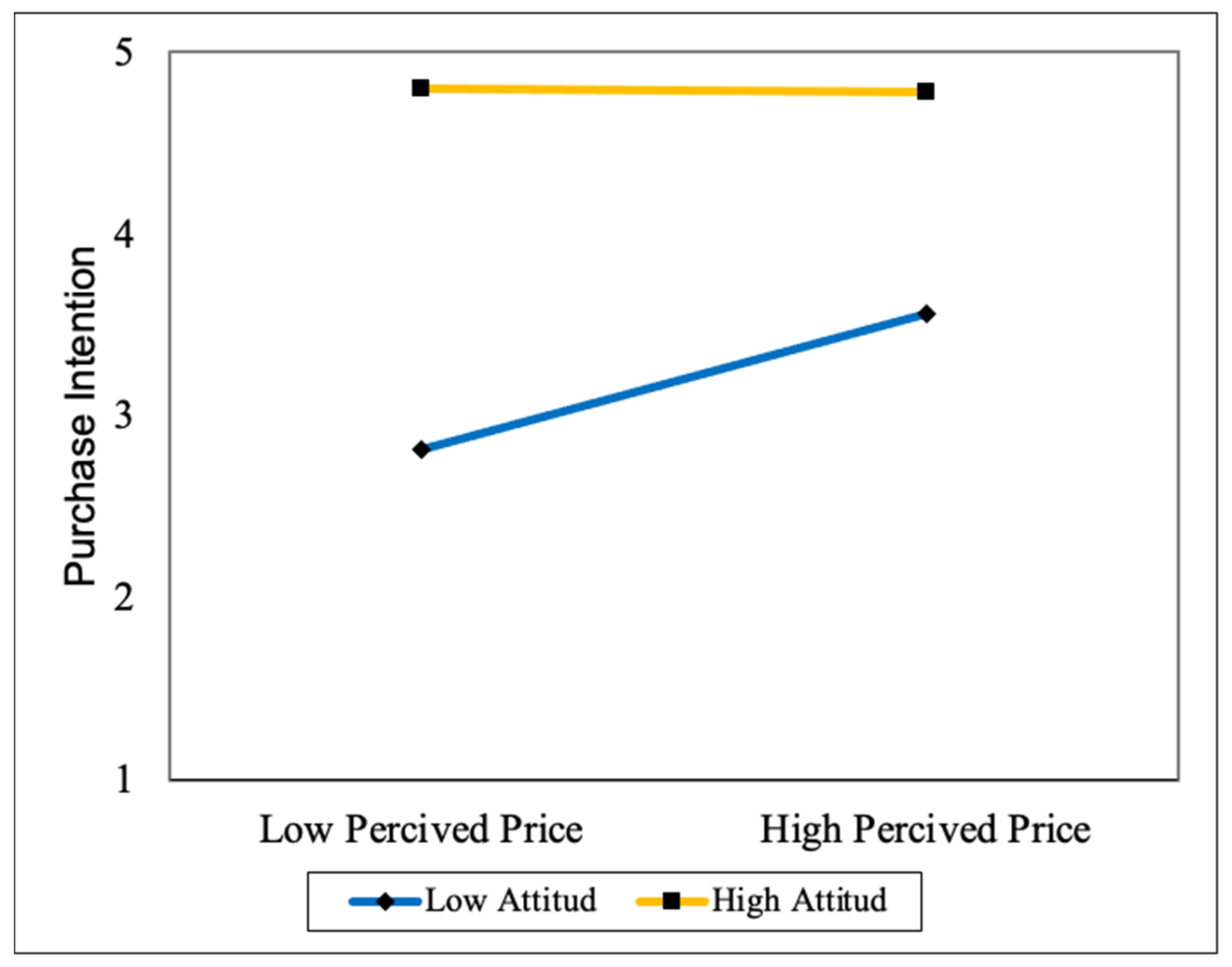
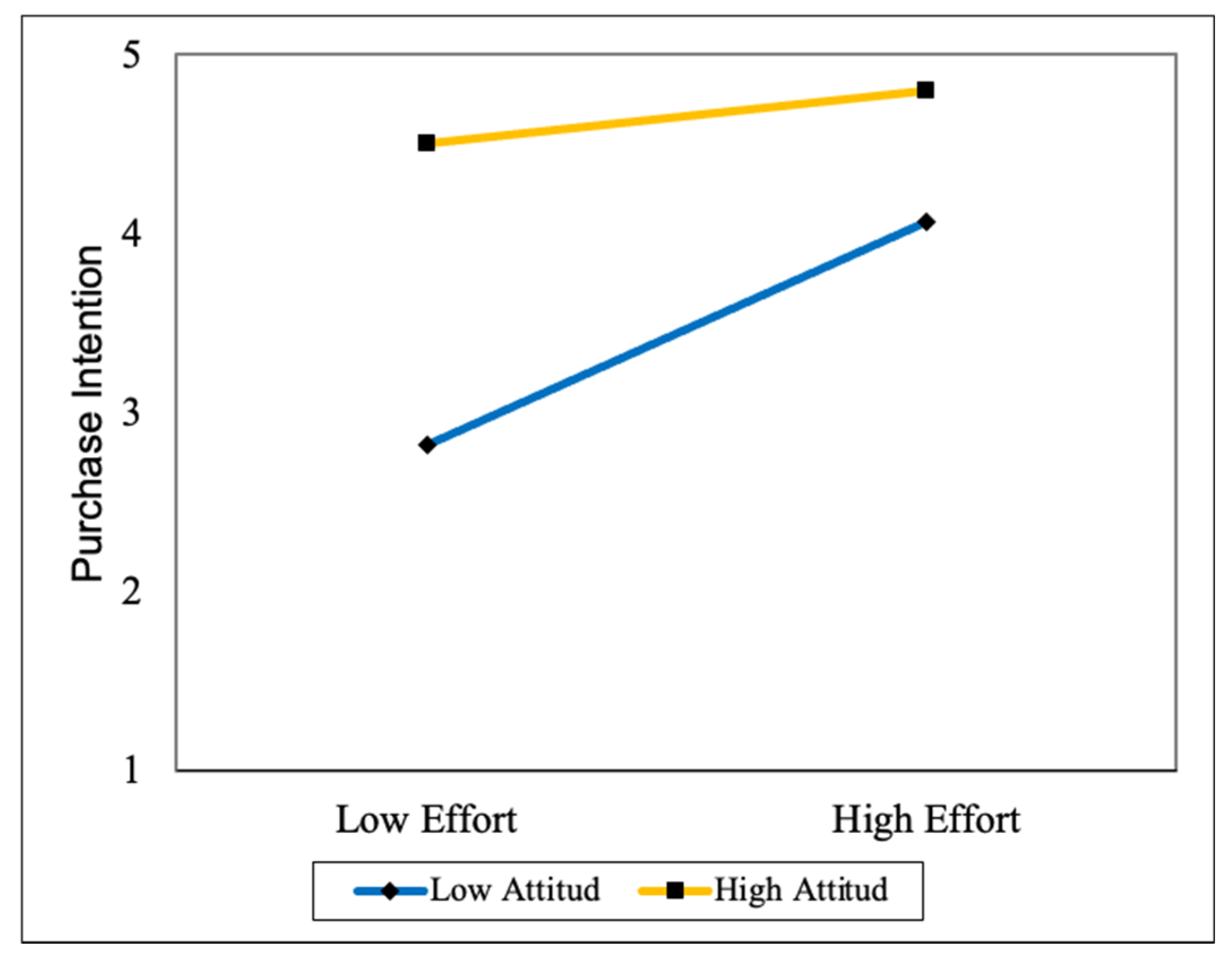
| Variables | Frequency | Percentage |
|---|---|---|
| Under 26 years old | 257 | 56.1 |
| 26 to 35 years old | 109 | 23.8 |
| 36 to 45 years old | 57 | 12.4 |
| 46 to 55 years old | 30 | 6.6 |
| Over 55 years old | 5 | 1.1 |
| Female | 241 | 52.6 |
| Male | 203 | 44.3 |
| I prefer not to say it | 14 | 3.1 |
| Married | 74 | 16.2 |
| Divorced | 3 | 0.7 |
| Single | 380 | 83 |
| Widowed | 1 | 0.2 |
| Primary/elementary education | 10 | 2.2 |
| Secondary education | 132 | 28.8 |
| Technical/professional higher education | 104 | 22.7 |
| University higher education | 196 | 42.8 |
| Masters Higher Education | 9 | 2 |
| Doctoral Higher Education | 7 | 1.5 |
| Presence of children at home | 237 | 51.7 |
| Presence of children under 12 years old | 186 | 40.6 |
| Factor | Indicators | Mean | SD | Loadings | AVE | Cronbach’s Alpha | Rho A | CR |
|---|---|---|---|---|---|---|---|---|
| Attitude | BA | 3.790 | 1.247 | 1.000 | – | – | 1.000 | – |
| Environment | EM1 | 3.836 | 1.275 | 0.853 | 0.700 | 0.823 | 0.824 | 0.823 |
| EM2 | 3.869 | 1.320 | 0.820 | |||||
| Fear | F1 | 3.120 | 1.314 | 0.660 | 0.629 | 0.830 | 0.849 | 0.834 |
| F2 | 3.546 | 1.316 | 0.891 | |||||
| F3 | 3.373 | 1.298 | 0.812 | |||||
| Health | H1 | 3.998 | 1.232 | 0.946 | 0.764 | 0.927 | 0.934 | 0.928 |
| H2 | 3.651 | 1.283 | 0.747 | |||||
| H3 | 3.832 | 1.264 | 0.906 | |||||
| H4 | 3.838 | 1.243 | 0.885 | |||||
| Purchase Intention | PI | 3.889 | 1.260 | 1.000 | – | – | 1.000 | – |
| Factor | Attitude | Environment | Fear | Health |
|---|---|---|---|---|
| Attitude | 1.000 | |||
| Environment | 0.770 | 0.837 | ||
| Fear | 0.627 | 0.772 | 0.793 | |
| Health | 0.773 | 0.803 | 0.700 | 0.874 |
| Purchase intention | 0.808 | 0.808 | 0.678 | 0.807 |
| Attitude | Environment | Fear | Health | Purchase Intention | |
|---|---|---|---|---|---|
| Attitude | 1.000 | ||||
| Environment | 0.770 | 0.837 | |||
| Fear | 0.627 | 0.772 | 0.793 | ||
| Health | 0.773 | 0.803 | 0.700 | 0.874 | |
| Purchase intention | 0.808 | 0.808 | 0.678 | 0.807 | 1.000 |
| Original Sample (O) | T Statistics (|O/SD|) | p-Value | 2.5% | 97.5% | |
|---|---|---|---|---|---|
| Attitude → Purchase intention | 0.344 | 5.292 | 0.000 * | 0.207 | 0.463 |
| Environment → Attitude | 0.426 | 3.991 | 0.000 * | 0.232 | 0.661 |
| Environment → Purchase intention | 0.277 | 3.017 | 0.003 * | 0.124 | 0.489 |
| Fear → Attitude | −0.007 | 0.097 | 0.923 | −0.138 | 0.125 |
| Fear → Purchase intention | 0.050 | 1.002 | 0.316 | −0.044 | 0.148 |
| Health → Attitude | 0.436 | 5.196 | 0.000 * | 0.251 | 0.574 |
| Health → Purchase intention | 0.284 | 3.680 | 0.000 * | 0.129 | 0.436 |
| Original Sample (O) | T Statistics (|O/SD|) | p-Value | 2.5% | 97.5% | |
|---|---|---|---|---|---|
| Environment → Attitude → Purchase intention | 0.146 | 3.465 | 0.001 * | 0.072 | 0.230 |
| Fear → Attitude → Purchase intention | −0.002 | 0.097 | 0.923 | −0.050 | 0.044 |
| Health → Attitude → Purchase intention | 0.150 | 3.568 | 0.000* | 0.065 | 0.230 |
| Hypothesis | Direct Relationships | Results |
|---|---|---|
| H1 | Health has a positive impact on organic fruit purchase intention | Supported |
| H2 | Health has a positive impact on attitude towards organic fruit | Supported |
| H3 | Consumer fear towards conventional products has a positive impact on purchase intention for organic fruit | Not supported |
| H4 | Consumer fear towards conventional products has a positive impact on attitude towards organic fruit | Not supported |
| H5 | Environmental motivations have a positive impact on the intention to purchase organic fruit | Supported |
| H6 | Environmental motivations have a positive impact on attitude towards organic fruit | Supported |
| H7 | Positive attitude toward organic fruit has a positive impact on purchase intention | Supported |
| Hypothesis | Indirect Relationships | Results |
| H8 | The relationship between consumer fear and purchase intention is mediated by attitude toward organic fruit | Not supported |
| H9 | The relationship between health and purchase intention is mediated by attitude toward organic fruit | Supported |
| H10 | The relationship between environmental motivations and purchase intention is mediated by attitude toward organic fruit | Supported |
| Hypothesis | Moderation Relationships | Results |
| H11 | The attitude toward organic fruit effect on purchase intention is moderated by perceived price. Thus, the higher the perceived price, the greater the attitude effect on purchase intention | Supported |
| H12 | The attitude effect toward organic fruit on purchase intention is moderated by effort. Thus, the greater the effort, the greater the attitude effect on purchase intention | Supported |
Publisher’s Note: MDPI stays neutral with regard to jurisdictional claims in published maps and institutional affiliations. |
© 2022 by the authors. Licensee MDPI, Basel, Switzerland. This article is an open access article distributed under the terms and conditions of the Creative Commons Attribution (CC BY) license (https://creativecommons.org/licenses/by/4.0/).
Share and Cite
Llanos-Herrera, G.; Vega-Muñoz, A.; Salazar-Sepúlveda, G.; Contreras-Barraza, N.; Gil-Marín, M. Environmental and Health Factors as Organic Fruit Purchase Drivers and the Mediating Role of Price and Effort. Horticulturae 2022, 8, 955. https://doi.org/10.3390/horticulturae8100955
Llanos-Herrera G, Vega-Muñoz A, Salazar-Sepúlveda G, Contreras-Barraza N, Gil-Marín M. Environmental and Health Factors as Organic Fruit Purchase Drivers and the Mediating Role of Price and Effort. Horticulturae. 2022; 8(10):955. https://doi.org/10.3390/horticulturae8100955
Chicago/Turabian StyleLlanos-Herrera, Gonzalo, Alejandro Vega-Muñoz, Guido Salazar-Sepúlveda, Nicolás Contreras-Barraza, and Miseldra Gil-Marín. 2022. "Environmental and Health Factors as Organic Fruit Purchase Drivers and the Mediating Role of Price and Effort" Horticulturae 8, no. 10: 955. https://doi.org/10.3390/horticulturae8100955
APA StyleLlanos-Herrera, G., Vega-Muñoz, A., Salazar-Sepúlveda, G., Contreras-Barraza, N., & Gil-Marín, M. (2022). Environmental and Health Factors as Organic Fruit Purchase Drivers and the Mediating Role of Price and Effort. Horticulturae, 8(10), 955. https://doi.org/10.3390/horticulturae8100955









